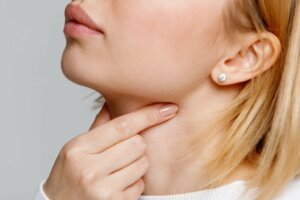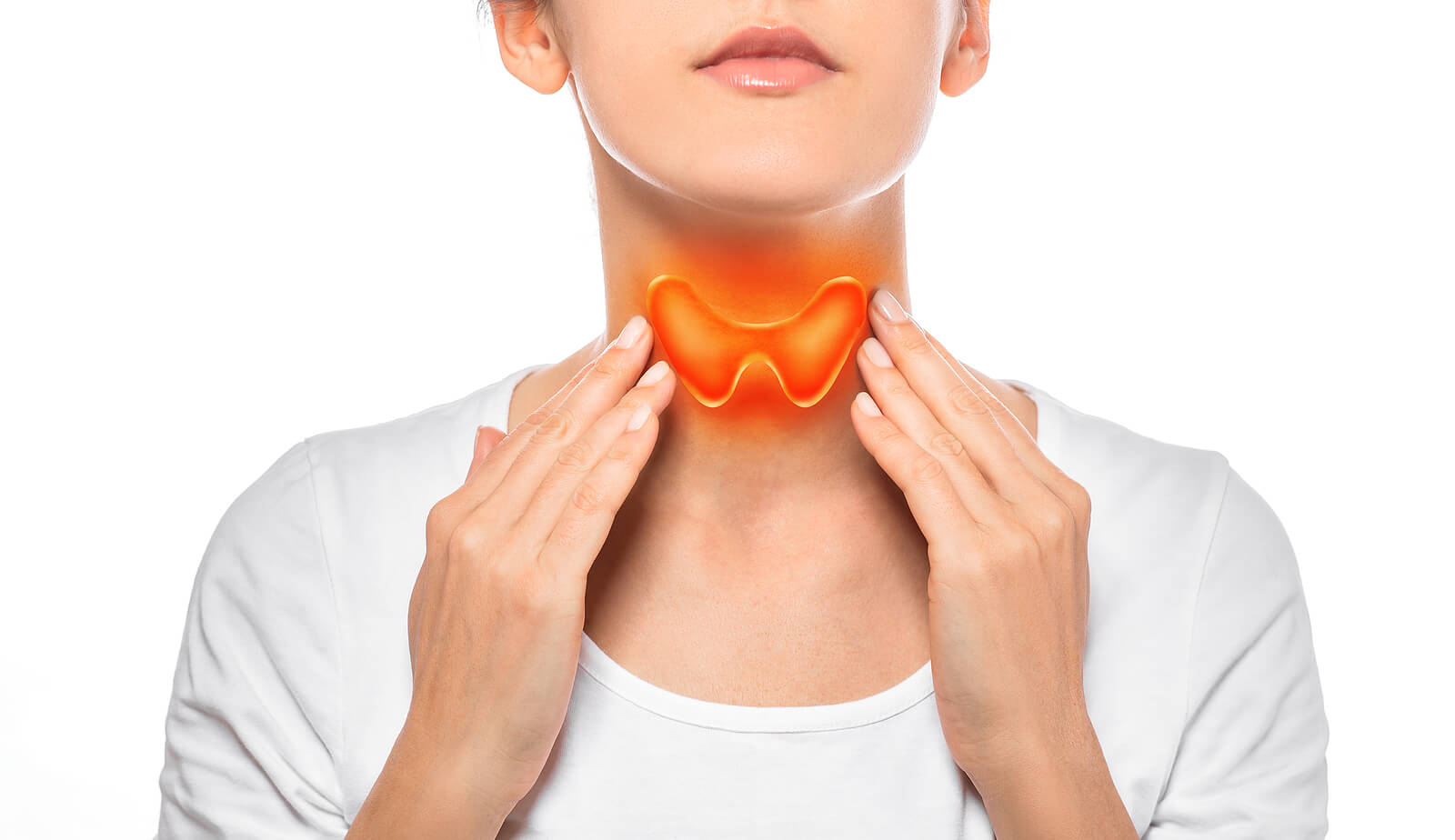Treatment of Hashimoto's Disease

The treatment of Hashimoto’s disease consists mainly of thyroid hormone replacement to reverse the symptoms that the disease produces.
Once the levels of TSH and T4 in the blood are regulated, the next objective will be to maintain them. But what does that replacement entail? What else can the treatment cover? We’ll explain it to you below in more detail.
Hashimoto’s disease is also known as chronic lymphocytic thyroiditis or autoimmune thyroiditis. It’s a disease of autoimmune origin. This means that the immune system attacks the thyroid and prevents it from making enough thyroid hormones.
In the early stages, many people have no symptoms. The disease can progress slowly and silently, and it isn’t until the symptoms are established that the person can go to the doctor, obtain the diagnosis and is prescribed treatment.
Considerations

As the experts from the American Thyroid Association explain, not everyone needs treatment for Hashimoto’s disease. To do this, a distinction is made between those with overt hypothyroidism, subclinical hypothyroidism, and Hashimoto’s disease without hypothyroidism. Which, in a few words, means that:
- People with elevated antibodies, but normal thyroid function tests (TSH and free thyroxine) don’t require thyroid hormone treatment. However, medical follow-up is important.
- However, people with elevated TSH and low thyroid hormone levels do require thyroid hormone replacement.
Prescriptions
Treatment for Hashimoto’s disease relies primarily on levothyroxine. However, depending on the case, it can be combined with other drugs.
Levothyroxine (T4)
According to experts, in relation to levothyroxine, it’s important to consider the following:
- The standard treatment for hypothyroidism is levothyroxine (i.e. synthetic thyroxine [T4]).
- This medicine is taken on an empty stomach, always making sure you use the same pharmaceutical formulation, as there are differences between the same medicine from different suppliers.
- The doctor can make recommendations on some foods and drinks you should avoid while taking the medicine, to prevent problems with its absorption.
- Women who want a pregnancy should consult their doctor about the most appropriate dose.
- Treatment requires medical monitoring. Blood tests are usually ordered after the first 6-8 weeks to check how effective it has been and if any adjustments are needed.
- Subsequently, an annual check-up with the endocrinologist is recommended. This isn’t only to check how the treatment is going, but also to prevent complications, such as nodules, for example.
Liothyronine (T3)
Mayo Clinic experts explain that: “There’s some evidence that T3 may offer benefits to certain subgroups of people, such as people who have had their thyroid surgically removed (thyroidectomy). Research is ongoing.”
Diet and supplements
Before including some multivitamin supplements, or only selenium, iodine, iron, vitamin D or vitamin B12 in the diet, it’s best to consult your doctor. This is because, even when they’re proposed as beneficial to improve thyroid function, there are cases where they can interact with prescription drugs and prevent the treatment from being effective.
On the other hand, experts indicate that seaweed supplements and herbal preparations “to improve thyroid function” can also interact with medication and produce counterproductive reactions. Because of this, it can not only end up prolonging the treatment, but also cause various complications.
Generally, before resorting to any type of supplement, experts recommend eating a healthy diet. It should be noted that, to date, there’s no diet as such for the treatment of Hashimoto’s disease, but the following is usually recommended:
- Avoid excesses of all kinds.
- Include probiotic foods in the diet regularly (to combat constipation).
- Maintain good hydration daily (to support the previous point and maintain general health).
- Consult your doctor about eating foods that contain large amounts of iodine (such as seaweed).
- Inform your doctor if you want to take supplements or maintain a high fiber intake (the latter because a high amount of fiber can interfere with the absorption of drugs).
Other lifestyle measures

It’s advisable to combine treatment for Hashimoto’s disease with a healthy diet and a good exercise routine. This can be coordinated with the doctor in consultation, as each person will have specific needs, depending on their sex, age, health status, and lifestyle.
Ideally, the person should exercise daily, for at least 30-40 minutes, 5 days a week.
The type of physical activity can be adjusted to your personal preferences and can range from light routines to moderate intensity routines in combination with some high-intensity exercises.
Some people choose disciplines such as yoga to exercise, because it helps them adopt a comfortable exercise rhythm and also allows them to improve their overall well-being. This is because this discipline works both the body (endurance, muscular strength, flexibility, etc.) and the mind (relieves stress, helps improve emotional management, etc.).
To complement all of the above, some people consider that it’s worth applying some relaxation techniques (such as mindfulness), mainly for stress management. They also help your overall well-being and allow you to enjoy a better quality of life.
If you’ve been diagnosed with Hashimoto’s disease and are already under treatment, but have questions about any aspect of the disease, don’t hesitate to consult your doctor. Don’t keep it to yourself, resolve it with the specialist so that you can take care of yourself and make progress.
The treatment of Hashimoto’s disease consists mainly of thyroid hormone replacement to reverse the symptoms that the disease produces.
Once the levels of TSH and T4 in the blood are regulated, the next objective will be to maintain them. But what does that replacement entail? What else can the treatment cover? We’ll explain it to you below in more detail.
Hashimoto’s disease is also known as chronic lymphocytic thyroiditis or autoimmune thyroiditis. It’s a disease of autoimmune origin. This means that the immune system attacks the thyroid and prevents it from making enough thyroid hormones.
In the early stages, many people have no symptoms. The disease can progress slowly and silently, and it isn’t until the symptoms are established that the person can go to the doctor, obtain the diagnosis and is prescribed treatment.
Considerations

As the experts from the American Thyroid Association explain, not everyone needs treatment for Hashimoto’s disease. To do this, a distinction is made between those with overt hypothyroidism, subclinical hypothyroidism, and Hashimoto’s disease without hypothyroidism. Which, in a few words, means that:
- People with elevated antibodies, but normal thyroid function tests (TSH and free thyroxine) don’t require thyroid hormone treatment. However, medical follow-up is important.
- However, people with elevated TSH and low thyroid hormone levels do require thyroid hormone replacement.
Prescriptions
Treatment for Hashimoto’s disease relies primarily on levothyroxine. However, depending on the case, it can be combined with other drugs.
Levothyroxine (T4)
According to experts, in relation to levothyroxine, it’s important to consider the following:
- The standard treatment for hypothyroidism is levothyroxine (i.e. synthetic thyroxine [T4]).
- This medicine is taken on an empty stomach, always making sure you use the same pharmaceutical formulation, as there are differences between the same medicine from different suppliers.
- The doctor can make recommendations on some foods and drinks you should avoid while taking the medicine, to prevent problems with its absorption.
- Women who want a pregnancy should consult their doctor about the most appropriate dose.
- Treatment requires medical monitoring. Blood tests are usually ordered after the first 6-8 weeks to check how effective it has been and if any adjustments are needed.
- Subsequently, an annual check-up with the endocrinologist is recommended. This isn’t only to check how the treatment is going, but also to prevent complications, such as nodules, for example.
Liothyronine (T3)
Mayo Clinic experts explain that: “There’s some evidence that T3 may offer benefits to certain subgroups of people, such as people who have had their thyroid surgically removed (thyroidectomy). Research is ongoing.”
Diet and supplements
Before including some multivitamin supplements, or only selenium, iodine, iron, vitamin D or vitamin B12 in the diet, it’s best to consult your doctor. This is because, even when they’re proposed as beneficial to improve thyroid function, there are cases where they can interact with prescription drugs and prevent the treatment from being effective.
On the other hand, experts indicate that seaweed supplements and herbal preparations “to improve thyroid function” can also interact with medication and produce counterproductive reactions. Because of this, it can not only end up prolonging the treatment, but also cause various complications.
Generally, before resorting to any type of supplement, experts recommend eating a healthy diet. It should be noted that, to date, there’s no diet as such for the treatment of Hashimoto’s disease, but the following is usually recommended:
- Avoid excesses of all kinds.
- Include probiotic foods in the diet regularly (to combat constipation).
- Maintain good hydration daily (to support the previous point and maintain general health).
- Consult your doctor about eating foods that contain large amounts of iodine (such as seaweed).
- Inform your doctor if you want to take supplements or maintain a high fiber intake (the latter because a high amount of fiber can interfere with the absorption of drugs).
Other lifestyle measures

It’s advisable to combine treatment for Hashimoto’s disease with a healthy diet and a good exercise routine. This can be coordinated with the doctor in consultation, as each person will have specific needs, depending on their sex, age, health status, and lifestyle.
Ideally, the person should exercise daily, for at least 30-40 minutes, 5 days a week.
The type of physical activity can be adjusted to your personal preferences and can range from light routines to moderate intensity routines in combination with some high-intensity exercises.
Some people choose disciplines such as yoga to exercise, because it helps them adopt a comfortable exercise rhythm and also allows them to improve their overall well-being. This is because this discipline works both the body (endurance, muscular strength, flexibility, etc.) and the mind (relieves stress, helps improve emotional management, etc.).
To complement all of the above, some people consider that it’s worth applying some relaxation techniques (such as mindfulness), mainly for stress management. They also help your overall well-being and allow you to enjoy a better quality of life.
If you’ve been diagnosed with Hashimoto’s disease and are already under treatment, but have questions about any aspect of the disease, don’t hesitate to consult your doctor. Don’t keep it to yourself, resolve it with the specialist so that you can take care of yourself and make progress.
- Aguilar Chasipanta Walter Geovanny, Barquin Zambrano Christian Rogelio, Washington Jordán Sánchez Jorge, Espinoza Álvarez Edlita Ivonne, Bayas Cano Ana Gabriela, Vaca García Mario Rene. Efectos del deporte sobre la glándula tiroides. Rev Cubana Invest Bioméd [Internet]. 2017 Sep [citado 2021 Jun 16] ; 36( 3 ). Disponible en: http://scielo.sld.cu/scielo.php?script=sci_arttext&pid=S0864-03002017000300013&lng=es.
-
“Enfermedad de Hashimoto | NIDDK.” n.d. Accessed June 16, 2021. https://www.niddk.nih.gov/health-information/informacion-de-la-salud/enfermedades-endocrinas/enfermedad-de-hashimoto#comer.
- Ibáñez Toda L, Marcos Salas MV. Actualización en patología tiroidea. En: AEPap (ed.). Curso de Actualización Pediatría 2017. Madrid: Lúa Ediciones 3.0; 2017. p. 161-74.
-
Hershman, Jerome. 2020. “Tiroiditis de Hashimoto – Trastornos Hormonales y Metabólicos .” In Manual MSD Versión Para Público General. https://www.msdmanuals.com/es/hogar/trastornos-hormonales-y-metabólicos/trastornos-de-la-glándula-tiroidea/tiroiditis-de-hashimoto?query=Tiroiditis de Hashimoto.
- Mahowald, Shelly, “Therapeutic effects of Yoga on Thyroid Disorders” (2019). Nursing Capstones. 116. https://commons.und.edu/nurs-capstones/116
-
Paja, Miguel, and José L. del Cura. 2018. “Tratamiento Con Glucocorticoides Intratiroideos En La Tiroiditis de Hashimoto Dolorosa. Resultado En 2 Pacientes.” Endocrinología, Diabetes y Nutrición 65 (9): 546–47. https://www.elsevier.es/es-revista-endocrinologia-diabetes-nutricion-13-articulo-tratamiento-con-glucocorticoides-intratiroideos-tiroiditis-S2530016418301812.
- “Patient Guide to the Management of Maternal Hypothyroidism Before, During and After Pregancy” (2007) de la Hormone Foundation (www.hormone.org), la filial de enseñanza pública de la Endocrine Society de Estados Unidos.
-
“Tiroiditis de Hashimoto (Tiroiditis Linfocítica).” 2016. American Thyroid Association. http://www.thyroid.org/wp-content/uploads/patients/brochures/espanol/tiroiditis_de_hashimoto.pdf.
-
Theimer, Sharon. 2017. “Es Poco Probable Que Una Dieta Sola Revierta Los Cambios Producidos Por La Enfermedad de Hashimoto.” Mayo Clinic News Network. 2017. https://newsnetwork.mayoclinic.org/discussion/es-poco-probable-que-una-dieta-sola-revierta-los-cambios-producidos-por-la-enfermedad-de-hashimoto/.
Este texto se ofrece únicamente con propósitos informativos y no reemplaza la consulta con un profesional. Ante dudas, consulta a tu especialista.







